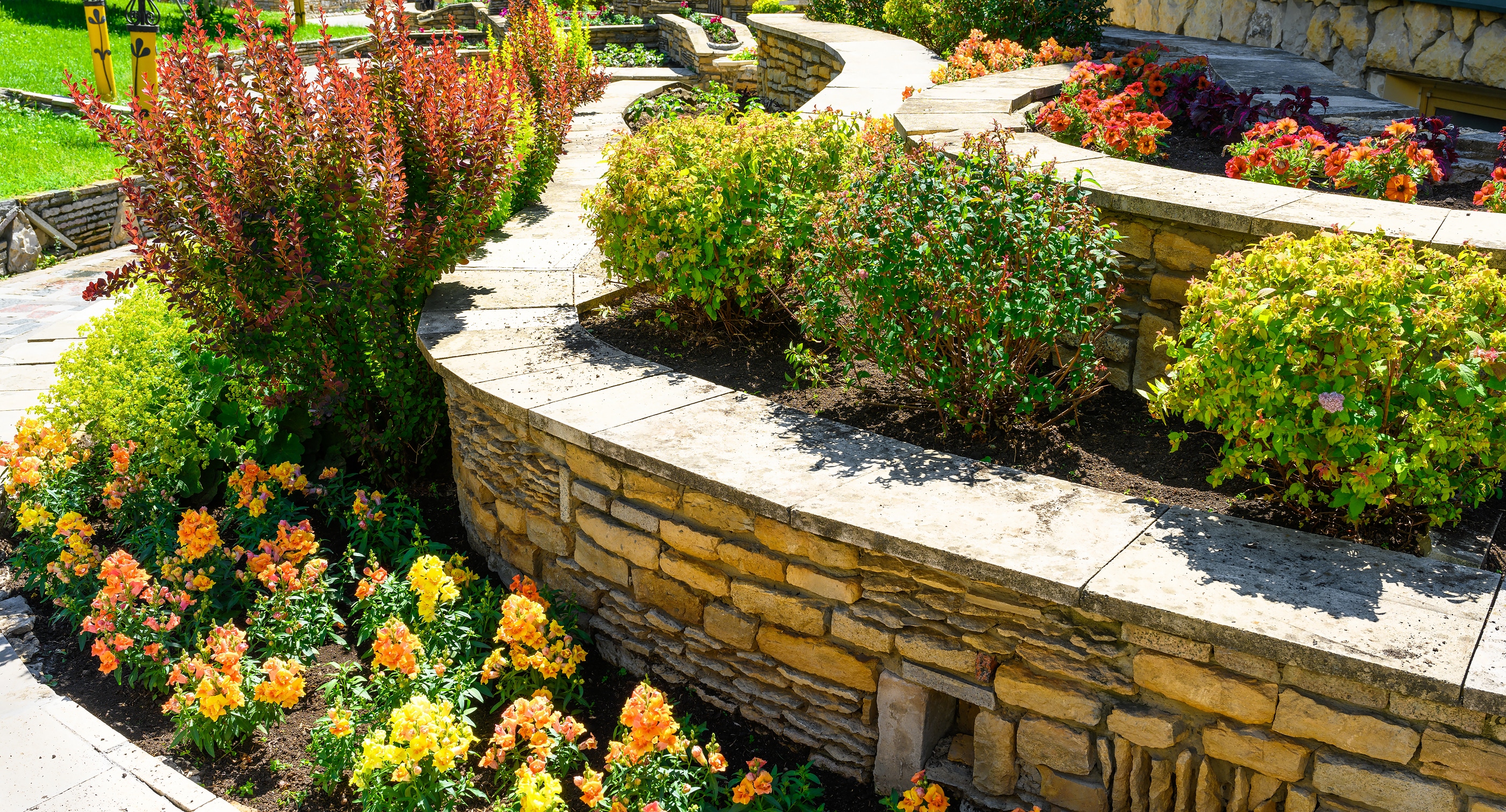Secret Factors To Consider for Structure Reliable Retaining Walls in Your Backyard
When you're considering building a preserving wall surface in your yard, it's essential to believe regarding numerous crucial factors. The wall surface's objective, the products you'll use, and the particular dirt conditions can all impact its efficiency and longevity. You'll also require to browse regional building regulations and plan for appropriate water drainage. But exactly how do you guarantee your design not only fulfills these needs however likewise enhances your landscape? Allow's check out the crucial actions with each other.
Recognizing the Purpose of Your Retaining Wall
When you think concerning constructing a keeping wall surface, consider its major objective: supporting dirt and protecting against erosion. Retaining walls offer necessary assistance for sloped landscapes, aiding to maintain dirt stability. You'll locate they're vital in locations where water overflow may or else remove dirt, leading to expensive repair services and landscape damage.
By keeping back planet, these walls develop level surfaces for yards, patio areas, or paths. This not only boosts your backyard's appearances however additionally advertises much better water drainage, decreasing water pooling in unwanted locations. If you're dealing with steep inclines, a sound retaining wall can prevent landslides, making sure safety for you and your home.
Eventually, recognizing the purpose of your retaining wall surface will lead your design choices and help you develop a practical, durable structure that fulfills your needs. Take a moment to examine your landscape; it'll pay off in the lengthy run.
Choosing the Right Products
When choosing products for your retaining wall surface, you'll desire to take into account sturdiness, appearances, and cost. Each aspect plays an important function in ensuring your wall stands the examination of time while looking wonderful and fitting your budget. Let's check out just how to make the finest selections for your project.
Material Longevity Factors
Choosing the best products is essential for the long life and performance of your retaining wall surface, because their resilience straight affects the wall surface's ability to stand up to environmental anxieties. Start by considering your neighborhood climate; materials like concrete and rock resist wetness and temperature fluctuations well. If you reside in an area susceptible to heavy rains, choose materials with good drainage residential or commercial properties, like crushed rock or permeable blocks, to avoid water build-up.
Some products carry out far better in specific dirt types, so it's important to match them as necessary. Choosing long lasting materials assurances your retaining wall surface stands solid, securing your backyard for years to come.
Visual Layout Selections
Durable products not just guarantee your retaining wall surface's architectural honesty however likewise play an essential role in its aesthetic allure. Do not fail to remember about the wall's form-- rounded walls can develop a softer appearance, while straight lines can feel a lot more structured. By thoroughly selecting products that line up with your visual vision, you'll improve your exterior space while guaranteeing your wall stands solid against the elements.
Cost-Effectiveness Analysis
Selecting the ideal products for your retaining wall surface isn't just about aesthetic appeals; it's also essential for your budget. When choosing products, take into consideration both upfront expenses and lasting sturdiness.
Don't forget to element in maintenance prices. Some products, like natural rock, can add charm and call for less upkeep, while others might require routine treatments
Inevitably, consider the benefits and drawbacks of each alternative versus your spending plan and the wall's designated purpose. Investing sensibly in products currently can prevent costly concerns in the future. Pick products that stabilize expense and efficiency properly.
Assessing Dirt Problems and Water Drainage
As you begin your project, examining soil conditions and water drainage is vital for the success of your retaining wall surface. Sandy dirt drains well yet does not have stability, while clay soil can keep wetness, leading to pressure on your wall.
Following, evaluate the incline of your backyard. If water naturally moves towards your wall, you'll require to execute a drainage remedy to protect against disintegration and pressure buildup. Take into consideration installing perforated pipes or gravel backfill behind the wall to facilitate water drainage.
Lastly, observe any type of close-by trees or plants; their origins can affect dirt stability. By recognizing your dirt conditions and carrying out appropriate water drainage, you'll develop a strong structure for your retaining wall that stands the test of time.
Following Local Building Codes
Before you begin developing your retaining wall surface, you need to research local policies to assure conformity. It's crucial to recognize what allows you must acquire, as this can conserve you from expensive fines or having to renovate your job. Taking these steps seriously will aid you build a secure and reliable structure.
Research Local Regulations
Understanding regional regulations is essential when intending your retaining wall surface job, particularly given that building codes can differ substantially by location. Look for guidelines on wall height, products, water drainage systems, and structural stability. By doing your research study upfront, you can ensure your retaining wall meets all required codes and blends perfectly right into your backyard.
Get Necessary Licenses
Once you've looked into local guidelines, the next action is to get the necessary permits for your retaining wall surface task. This process guarantees your wall surface abides by building ordinance and safety and security standards. Connect to your neighborhood building authority to figure out what permits you need. They may need certain plans or design assessments, especially for larger walls. Be prepared to send comprehensive drawings, including measurements and materials. Don't fail to remember to check if your project impacts water drainage or bordering buildings, as these variables may require additional authorizations. Safeguarding the ideal authorizations can conserve you from pricey fines or having to dismantle your wall later. Bear in mind, complying with the rules currently will cause a smoother construction experience.

Planning the Layout and Visual Appeal
As you start planning the design and appearances of your retaining wall, take into consideration just how it will harmonize with the bordering landscape. Consider the materials you'll use-- stone, block, or concrete-- and how they'll enhance your home's design and the natural environments in your lawn. Pick shades and textures that mix effortlessly with existing attributes like patio areas, paths, or yards.
Following, envision the wall surface's shape and elevation. Rounded walls can soften additional resources an inflexible landscape, while straight lines may communicate an extra contemporary appearance. Don't fail to remember to integrate plants and plant around the wall surface for an all-natural touch; this can boost its allure and integrate it into the environment.
Finally, bear in mind performance. Your style should not only be aesthetically pleasing however also offer its purpose efficiently. By thoughtfully planning these aspects, you'll produce a keeping wall surface that enhances your lawn's beauty while fulfilling its architectural role.
Computing Height and Thickness Needs
To build a strong retaining wall surface, you need to precisely calculate its height and density needs based upon the dirt problems and the elevation of the incline it will support. Beginning by evaluating the incline's angle and the type of soil, as various soils apply differing quantities of pressure.
For walls over four feet high, consider a density of at the very least 12 inches. If the wall surface is taller, enhance the density proportionally to preserve security.
Following, determine the elevation of the wall by gauging the vertical distance it needs to keep. For every single foot of elevation, you ought to typically intend for a density of one-third of the wall's height.
Always bear in mind to make up extra variables like water drainage and backfill, which can affect your wall's design. Correct estimations currently assure your retaining wall surface stands strong and lasts for several years to come.
Maintenance and Durability Factors To Consider
While maintaining your retaining wall might feel like a low top priority, disregarding it can cause significant concerns with time. Normal assessments are vital; look for cracks, protrudes, or any indicators of water damage. Dealing with these issues early can save you from expensive repairs down the roadway.
Keep an eye on water drainage systems, as well. Blocked drains can create water to develop, applying pressure on your wall and compromising its security. Clear debris and assurance appropriate circulation to preserve longevity.
You might also desire to assess address securing your wall surface to secure it from dampness and weathering. Depending upon the product, this might need reapplication every couple of years.
Last but not least, landscaping around your wall surface can support its stability. Stay clear of planting large trees close by, as their roots can undermine the foundation. With aggressive upkeep, your retaining wall surface can serve you well for years to find.

Often Asked Concerns
Can I Construct a Retaining Wall by Myself, or Should I Employ a Specialist?
You can most definitely build a retaining wall surface on your own if you have the right devices and understanding. However, working with a specialist assurances it's done appropriately, particularly for larger or even more complicated frameworks. Consider your ability level prior to deciding.
What Are one of the most Typical Blunders Made When Building Retaining Walls?
When constructing retaining walls, you could overlook correct drainage, miss utilizing the right materials, or overlook reinforcement. These common blunders can result in architectural failing, so take your time and plan thoroughly to stay clear of issues.
Exactly how Do I Know if My Retaining Wall Demands Reinforcement?
You'll know your retaining wall needs reinforcement if you see fractures, leaning, or protruding. Look for water merging behind it or soil erosion near the base. Address these indications without delay to stop additional damages.
What Plant kingdom Appropriate for Landscaping Around a Retaining Wall?
When landscape design around a retaining wall, think about using low-maintenance plants like succulents, ornamental grasses, or creeping ground covers - OKC Precision Retaining Walls. They'll prosper in those problems and include elegance while stopping dirt disintegration around your wall
Exactly How Can I Protect Against Erosion Around My Retaining Wall?
To avoid erosion around your retaining wall, you can grow ground cover, use compost, and install drain systems. Regularly look for check here water accumulation and adjust landscape design to reroute runoff far from the wall.
 Luke Perry Then & Now!
Luke Perry Then & Now! Ben Savage Then & Now!
Ben Savage Then & Now! Molly Ringwald Then & Now!
Molly Ringwald Then & Now! Macaulay Culkin Then & Now!
Macaulay Culkin Then & Now! Catherine Bach Then & Now!
Catherine Bach Then & Now!